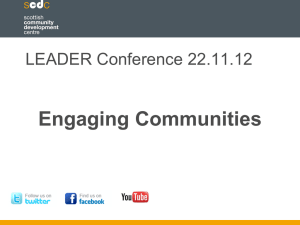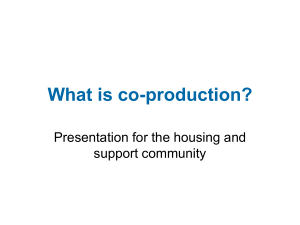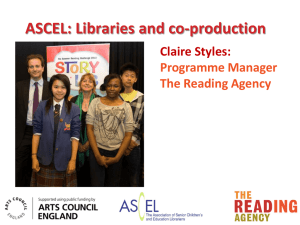From Consumer Involvement to Co-production
advertisement
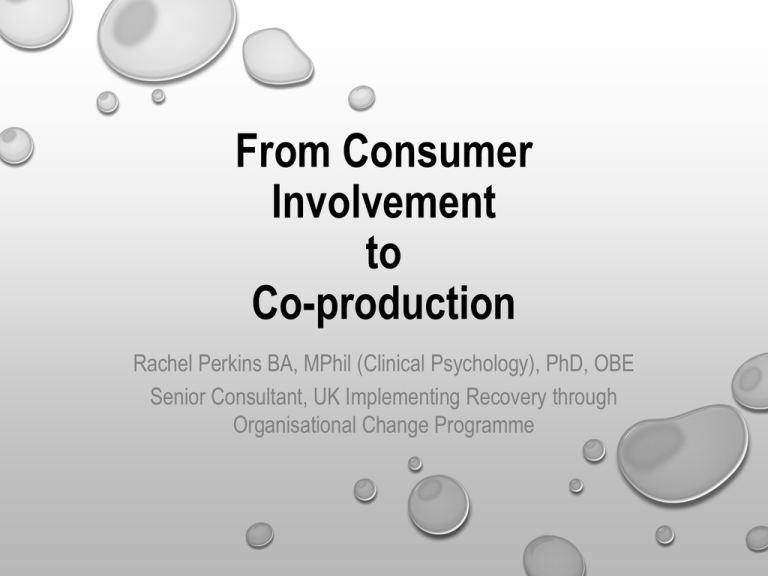
From Consumer Involvement to Co-production Rachel Perkins BA, MPhil (Clinical Psychology), PhD, OBE Senior Consultant, UK Implementing Recovery through Organisational Change Programme A view from 4 perspectives • 33 years working in NHS Mental Health Services: from clinical psychologist to director • 25 years using mental health services (both inpatient and outpatient) • Over 20 years involvement in policy development on various UK Government committees and advisory groups (including an independent review to Government ‘Realising Ambitions. Better employment support for people with a mental health condition’, 2009) Everyone who experiences mental health challenges faces the challenge of recovering a meaningful, satisfying and contributing life • • • • finding meaning in what has happened finding a new sense of self and purpose discovering and using your own resources and resourcefulness growing within and beyond what has happened to you Recovery is “a way of living a satisfying, hopeful and contributing life even within the limitations caused by illness. ... a deeply personal, unique process of changing one’s attitudes, values, feelings, goals, skills and roles. Recovery involves the development of new meaning and purpose in one’s life as one grows beyond the catastrophic effects of mental illness.” (Anthony 1993) Everyone’s recovery journey is different, but three things seem to be particularly important Hope Believing that a decent life is possible Control and selfdetermination Control over your life and destiny, the challenges you face and the help you receive Opportunity and citizenship The opportunity to do the things you value and participate as an equal citizen (See for example, Anthony, 1993; Repper and Perkins, 2003; Shepherd et al, 2007; Perkins and Slade 2012; Perkins and Repper 2012) If mental health services are to support people in their journey of recovery a different relationship is required: a change in the balance of power between mental health workers and those whom they serve • Traditional services recognise one set of experts – The mental health workers and the patients/clients/consumers: ‘them’ and ‘us’ – Assumed that mental health workers are the experts – Therefore it is mental health workers’ job tell ‘them’ what is wrong with them and what they should do to put things right • Recovery – focused services recognise two sets of experts – Experts by profession, qualification and degrees – expertise based on professional research and theories – Experts by lived experience – expertise based on personal experience and personal narratives • Creating more recovery-focused services requires that we recognise the expertise of lived experience onequal terms with that of professional expertise • How can we make the most of the expertise of lived experience in our services? • How can we bring together the expertise of lived experience and professional expertise in a different kind of relationship? A different kind of relationship changing the balance of power • Mental health professionals ‘on tap’ not ‘on top’ Putting our knowledge and expertise at the disposal of those who may find it helpful rather than telling people what to do • At an individual level – Supporting self-management rather than fixing people Helping people to discover and use their own resources and resourcefulness: mental health workers cannot make people recover but they can be catalysts - facilitators of change rather than creators of change – Enabling people to access the expertise of lived experience not only the expertise of mental health workers – Shared decision making at an individual level “Shared decision making … assumes that two experts—the client and the practitioner— must share their respective information and determine collaboratively the optimal treatment.” (Deegan and Drake, 2006) • Co-production in service design, delivery and development … Traditional ‘consumer involvement’ Involving ‘them’ in ‘our’ services: • Consultation: asking for ‘consumer’ opinions on plans or proposals developed by mental health workers … or offered ‘choice’ between a couple of options determined by mental health workers • A customer service approach: asking consumers ‘what do you want?’ … with mental health workers/services expected to deliver what consumers want ... or often explaining why they can’t deliver it ‘yes, but ...’ Often: • One or two service consumers on ‘our’ committees, interview panels etc. (no control over agenda, job descriptions, always in a minority ...) • ‘Consumers’ seen as undifferentiated - defined only by consumer status not other skills and attributes they may have • Outcomes defined by service providers (reduced bed days, throughput, medication compliance ...) Alison Cameron, London, describes her experience of ‘consumer (user) involvement’ “I found the experience of being a passive recipient of care dehumanising, disempowering and disenfranchising. I felt patronised and invalid.” then “Somewhere … I managed by chance to make contact with others who were successfully managing their alcohol problems and mental health issues and experienced the tiniest glimmer of hope … “I started to claw myself back with the help of my peers. I started to take power back… I started to become a participant in my own recovery … I started to notice what was going on around me and note that things needed to be improved.” “I trained as a mental health advocate, began to speak at conferences, write articles, campaign, rattle cages … In fact I was almost the poster child for ‘service user involvement’.” but “I became increasingly disillusioned that I was simply being wheeled out to create the illusion of commitment to … ‘involvement’, ‘empowerment’ etc. but I could see that my involvement was to a great degree tokenistic and that professionals often had a profound fear of competent, forthright service users who were often at least as well-informed as they were.” Co-production “Co-production ...is not the same as consultation or the types of tokenistic participation of people who use services and their carers which do not result in meaningful power-sharing or change.” Needham, C (2009) SCIE Research briefing 31: Co-production: an emerging evidence base for adult social care transformation “Co-production goes well beyond user [consumer] involvement ... It promotes equal partnership between service workers and those intended to benefit from their services – pooling different kinds of knowledge and skill, and working together.” “Co-production means designing and delivering public services in an equal and reciprocal relationship between professionals, people using services, their families and their neighbours. Where activities are co-produced in this way, both services and neighbourhoods become far more effective agents of change.” New Economics Foundation (2011) In This Together. Building knowledge about co-production NESTA (2009)The Challenge of Co-production NESTA (2012) People Powered Health Co-Production Catalogue Co-production • Challenges the conventional model of public services … ‘Product’ delivered to a ‘customer’ from on high Devolvement of power, choice & control to people using services, communities and frontline staff • Requires a shift in mind-set … People using services being seen as ‘burdens on an overstretched system’ People using services as assets: the ‘real wealth’ too often untapped & wasted resources Central features of co-production Needham, C (2009) SCIE Research briefing 31: Co-production: an emerging evidence base for adult social care transformation • the people who use services are experts in determining their own requirements • people who use services play an active role in meeting their own needs, rather being passive dependents/recipients of services • mutual aid between people who use services, promoting new mechanisms of peer support • broader community (including families) are active in the production of support, offering a collective model of co-production • involves a redefinition of what constitutes an ‘outcome’ in public services, focusing on those things that are important to people who use services (often less tangible issues like relationships and quality of life) co-productive approaches can be used with different people who use services (people with mental health conditions, physical impairments, dementia ...) Consumer and professional roles in the design and delivery of services Professionals as sole service planner Professionals and consumers/ communities as coplanners No professional input into service planning Professionals as sole service deliverers Traditional professional service provision Professional service provision but consumers involved in design Professionals as sole service deliverers of consumer designed services Professionals and consumers/ communities as co-deliverers Consumer codelivery of professionally designed services Full co-production Consumer codelivery of consumer designed services Consumers/ communities as sole deliverers Consumer delivery of professionally designed services Consumer delivery of co-designed services Self-organised, consumer run provision (Adapted from Carneige Trust (2006) ‘Commission for rural community development. Beyond Engagement and participation, user and community co-production of services) Responsibility for delivery of services Responsibility for the planning and design of services There is no one ‘correct’ way of doing coproduction … but there are 6 key principles (see Boyle et al, 2010; New Economics Foundation 2011; Alakeson, 2013) 1. Recognising people as assets (rather than problems) Transforming people who use services from passive recipients of services and burdens on the system into equal partners in designing and delivering services. • Lived experience of mental health conditions and the expertise people have gained as a result is valued • People who use services have many ‘hidden talents’ other than their experience of mental health challenges and using services (qualifications, skills, knowledge, expertise, personal qualities …) 2. Building on people’s capabilities (rather than just focusing on their needs) Altering the delivery model of public services from a deficit approach to one that provides opportunities to recognise and grow people’s capabilities and actively support them to put these to use with individuals and communities. 3. Mutuality and reciprocity (rather than passive consumption of public services) Offering a range of incentives to engage that enable people to work in reciprocal relationships with professionals and with each other, where there are mutual responsibilities and expectations. Share responsibilities rather than staff doing everything. 4. Peer and community networks (that complement bilateral relationships between professionals and consumers) Engaging peer and personal networks alongside professionals as the best way of building knowledge and supporting change. 5. Shared roles: blurring distinctions between producers and consumers (with consumers being actively involved in producing outcomes) Dissolving distinctions between professionals and recipients, and between producers and consumers of services, by reconfiguring the way services are developed and delivered. • Moving beyond ‘them’ and ‘us’ to ‘we’ • Sharing responsibility for delivery as well as deciding what should be delivered 6. Facilitating rather than just delivering services Enabling public service agencies to become catalysts and facilitators of change rather than sole providers of services themselves. • Shifting from ‘delivering services’ to supporting things to happen • Catalysts to development of networks and supports • Services cannot fix people but hey can support people in their journey of rebuilding their life … recognising and using their own resources and resourcefulness and the resources available to them in their networks and communities Example of co-production in practice Establishing the first Recovery College in the UK Initial development • 3 consumers and two mental health workers starting with a blank sheet of paper • Consumers selected for the skills and interests they brought - as well as lived experience of mental health problems and using services: all had training experience, one expert in project design, sales experience … • Shared responsibility for: – – – – – – Research Sounding out opinions of stakeholders Setting up a steering group (including agreeing who we needed to be on it) Actually writing the proposal Presenting at the Board Finding venue(s) • Advertising for mental health workers, consumers, relatives/friends who may be interested in being involved • Prospective staff and peer trainers did 4 day ‘introduction to recovery’ course (8 consumers, 2 relatives, 8 staff) • Meeting to decide what initial courses should be provided (what research showed people wanted, what skills we had in the room) • Developed guidelines for course development (aims, objectives, session plans …) • Established a course development panel • Divided up the task - pairs/small groups went off and developed courses e.g. ‘understanding self-harm course’ development group: – consumer who self-harmed … and also had a PhD in self-harm – a social worker – the father of a young woman who self-harmed • All courses co-delivered • Learning together: students = mental health workers, consumers, relatives, friends, people from the community … courses use all the expertise in the room - not all ‘chalk and talk’ - participative, democratic learning • Using feedback to improve courses, design new ones - co-production is an ongoing process • Dealing with disagreements – can (and should) present different points of view – discussion with course development group • All peer and staff trainers did ‘train the trainers’ course • Selection of trainers … not everyone who volunteered had the skills: – • • • • • • • Different jobs suiting different skills … opportunities for co-production include: Operational policy Design of prospectus and other materials Selection of staff Layout of venue - posters etc. Setting up data base and web site Development of the library Personal tutors • • • • • • Learning plans Evaluation and quality assurance Publicity, communications and marketing Student handbook Business meetings Course development board 1. Recognising people as assets • Peer trainers: expertise of lived experience and (rather than problems) other skills and assets • Peers using other skills in all areas of recovery college (marketing, library, material design etc.) 2. Building on people’s capabilities (rather than just focusing on their needs) • Range of skills of consumers recognised: focus on what person can do and how they can contribute in different roles • Participative learning - expertise of students as well as expertise of trainers • Using community resources - housing associations, job centres etc. 3. Mutuality and reciprocity • Shared responsibility for all aspects of design and (rather than passive delivery consumption of public services) • Shared learning and students sharing expertise with each other 4. Peer and community networks (that complement bilateral relationships between professionals and consumers) • Peer support from peer trainers • Peer support from fellow students - building knowledge together by learning from each other • Naturally occurring networks outside: courses co- produced with housing providers, employment providers, colleges … • Blurring distinctions as providers: peer and 5. Shared roles: blurring mental health trainers distinctions between producers and consumers (with • Blurring distinctions as students: consumers, consumers being actively mental health workers, carers, community involved in producing members working together outcomes) • Trainers as facilitators not instructors - enabling 6. Facilitating change rather students to recognise and develop their own than just delivering services resources • Sharing of expertise and knowledge among students Co-production means doing things differently New Economics Foundation (2011) In This Together. Building knowledge about co-production • Changing the way services are developed by – mapping assets and resources as well as problems and needs – working with people who use services and the wider community to decide what services and support are needed – ensuring people involved with services have a role to play in determining and assessing their success • Changing the way services are delivered – engaging peer support as a core function – reviewing organisational roles to ensure service providers are accountable to the people and communities that use them – encouraging and valuing reciprocity within service provision Co-production means doing things differently New Economics Foundation (2011) In This Together. Building knowledge about co-production • Changing the way mental health staff work – reviewing recruitment and appraisal processes so that they better represent what really matters to people using services – ensuring that building the skills and capacities of people to do things for themselves becomes central to the role of professionals – reviewing the language used by services to provide a truer reflection of the partnership between citizens and professionals – making personal relationships a critical aspect of a service not something to be fearful of New Economics Foundation (2011) In This Together. Building knowledge about co-production Co-production means doing things differently • From consultation – to working together to understand constraints and define possibilities • From asking ‘consumer opinions’ on proposals to working together to develop the proposals in the first place – starting from a blank sheet of paper • From professionals taking responsibility for providing what service consumers want to shared responsibility for design and delivery • From token representation to equal partnership • From service defined outcomes to consumer defined outcomes • From ‘consumers’ as an undifferentiated mass to recognition of range of assets, talents and resources - the untapped wealth in our services From ‘them’ and ‘us’ to ‘we’ From ‘yes, but ...’ to ‘yes, how ...’ Co-production is not easy … • For staff and service users it means major changes: moving from the ‘trenches’ of ‘them’ and ‘us’ to the ‘no man’s land’ in between – Mental health workers have to accept that ‘the experts don’t always know best’ – Consumers have to accept responsibility not only for saying what should be done but also for delivering it – Moving beyond criticism of each other to recognising each other’s strengths and contribution • Working out new relationships takes time and effort! But co-production can transform services and transform lives: Sue Williams’ experience (2012) From burden to asset “A report written about me in 2010 started with the words ‘Ms Williams is a very vulnerable woman with many complex needs’ … but as a result of co-production I have been transformed from a burden to an asset! …This transformation has been amazing not only do others now have radically altered perceptions of me, my own self-perception has changed radically from difficult, dependent patient to contributing, highly valued colleague. This transformation feels almost magical … How did that happen? Well an important way was being asked to … use my lived experience - and other skills to co-develop policy, provision and training. I am on a steering committee and I coproduce and co-facilitate training at the Recovery College, as a well as working as a peer support worker in a ward. In all these settings I have moved from being a passive and unhappy recipient and survivor of services to a thriving and valued colleague.” Engaging peer and personal networks “As recently as 2010 the only adults I had contact with were within ‘services”. The long list of ‘helping’ professionals The long list of ‘helping’ professionals included psychiatrists, psychiatric nurses, therapists, social workers, family workers and lawyers. My diary was full of appointments with them all. More recently, through co-production my social network has changed dramatically … I got involved with all sorts of people in different capacities through peer support training and groups, in policy and provision meetings and at the recovery college. I addressed the debts that were dragging me down with help from the CAB, I have become a parent Governor at my children’s school – an important achievement considering that throughout 2010 I was in the family court every fortnight where my ability to be a good enough mother to my children was being scrutinised. I no longer have a social worker, or a CPN – I have sole care of my children, I have friends and colleagues and an active role in my community.” Shared roles: blurring distinctions between producers and consumers “I moved from only having contact with professionals as a patient in their services to working alongside those same staff who once treated me . Initially I thought this might be a difficult position for both myself and those who have worked with me and was worried about how they might respond. What I experienced was a delighted response from staff who without exception all said how great it was to have me as part of their team. Some commented that it was rare and rewarding for them to see users of their service when they were well and this gave them a more positive view of the reality of recovery. There is no sense of ‘them and us’ and I feel that the unique perspective that I brought having been a patient on the ward … was genuinely appreciated. I saw how perceptions and stereotypes relating to mental health could be transformed by having someone that used to be a patient on the ward working there. More than one member of staff and a number of patients have said “I can’t believe that you were ever on the ward.” Many said in different ways that they were personally inspired having seen it was possible. I know where they are coming from because two years ago I could not have even imagined it was possible!”


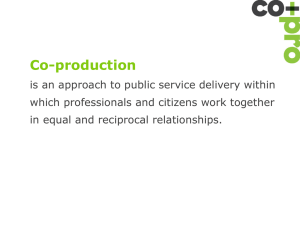
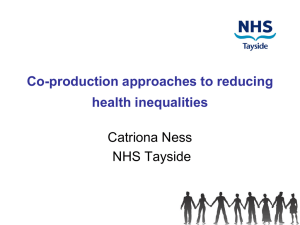
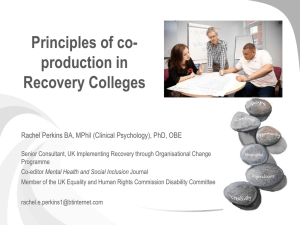
![Transformational Change [Powerpoint Presentation]](http://s2.studylib.net/store/data/005447411_1-da0a83bd34bdb90183940ab700125003-300x300.png)
